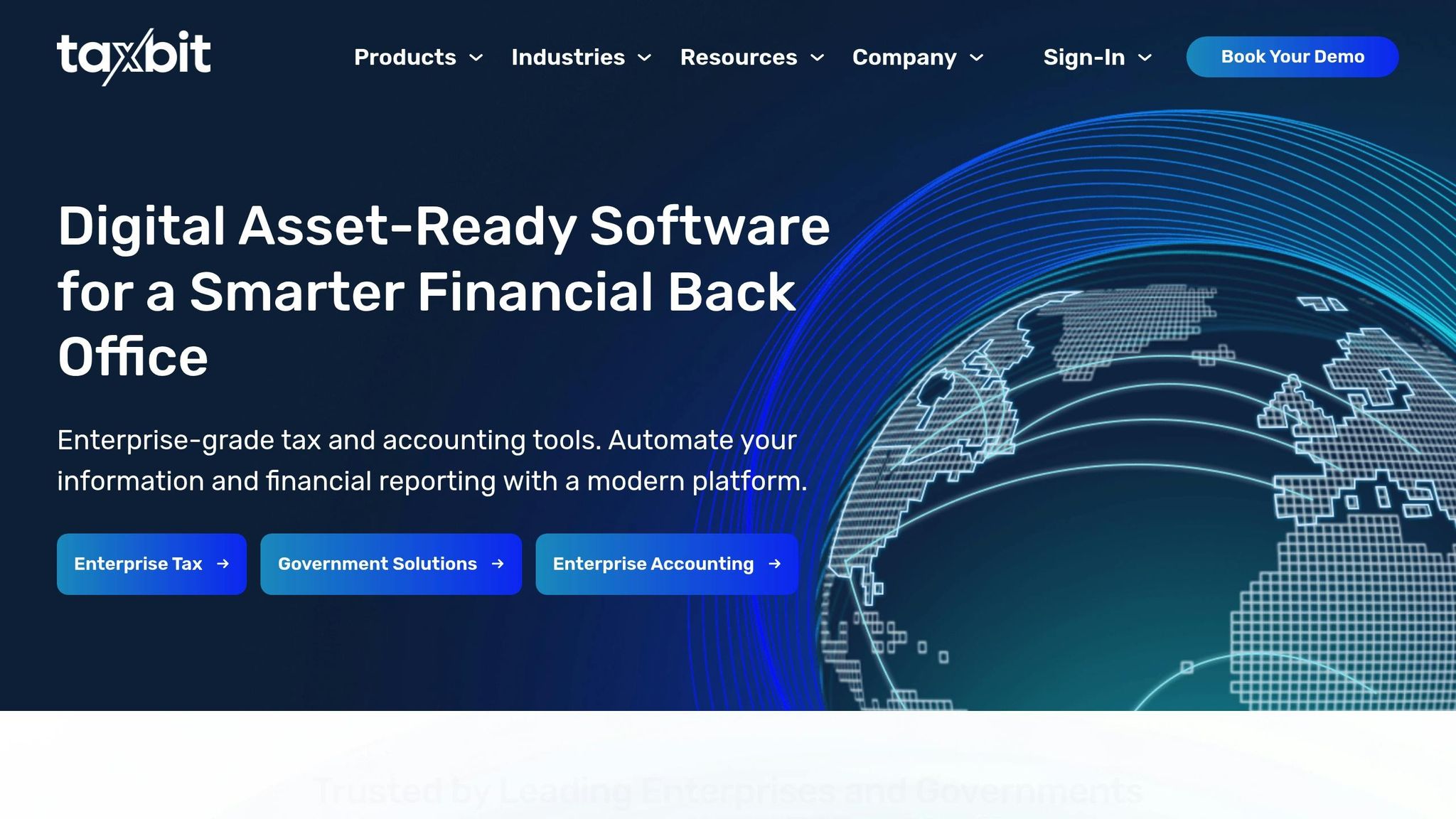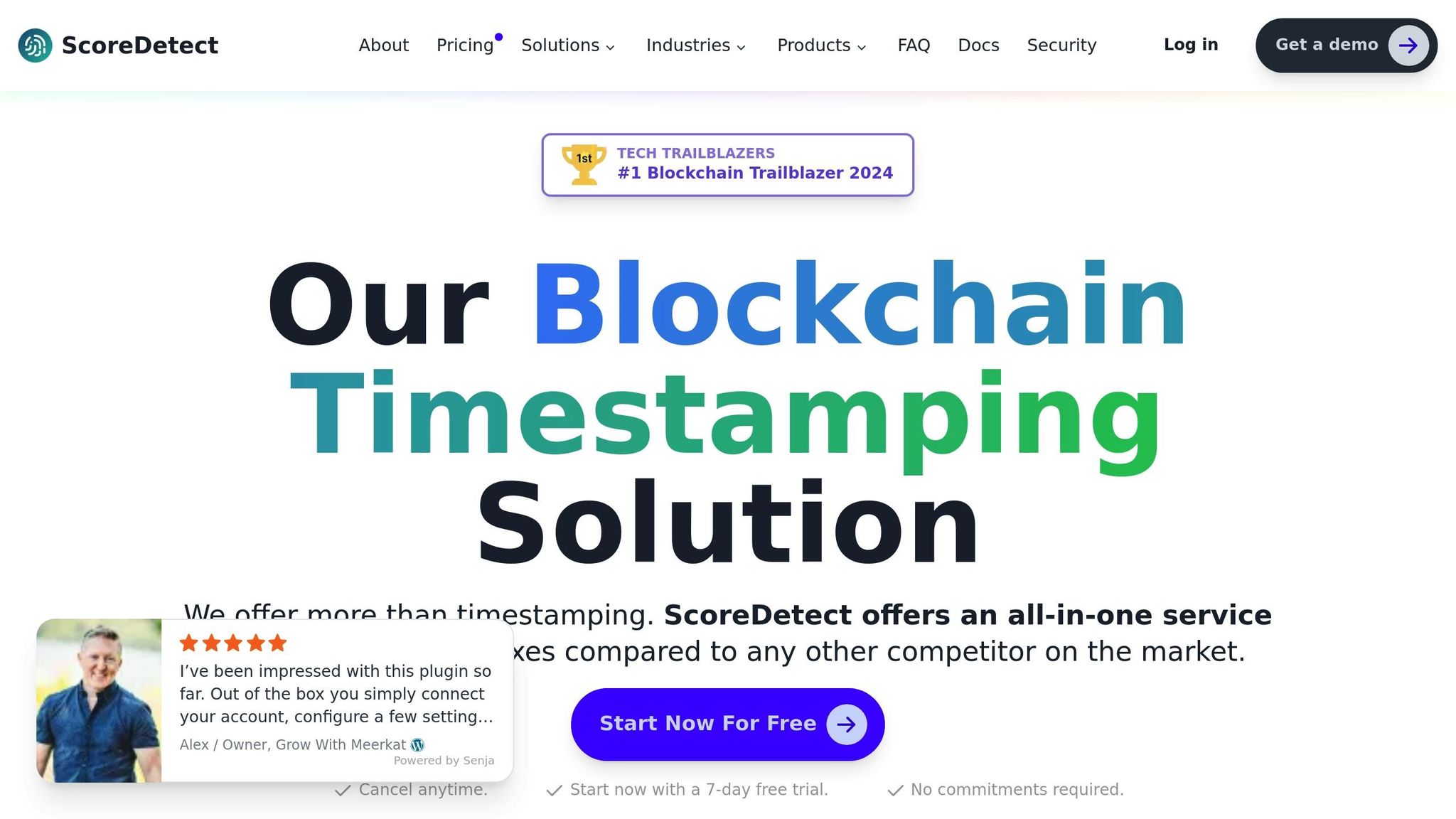Tax compliance for digital assets like cryptocurrencies and NFTs is no longer optional – it’s mandatory. With evolving global regulations, including stricter IRS rules starting in 2026, staying compliant is critical to avoid penalties. Here’s what you need to know:
- Who Must Comply: All U.S. taxpayers involved in digital asset transactions – individuals, businesses, brokers, and custodians.
- IRS Reporting Requirements: Report taxable events like sales, staking rewards, and mining income on forms such as 8949, 1040, and the upcoming 1099-DA.
- Record-Keeping: Maintain detailed records of transaction dates, amounts, counterparties, and jurisdictions.
- Cross-Border Transactions: Understand international tax treaties and frameworks like the OECD’s Crypto-Asset Reporting Framework (CARF) to avoid double taxation.
- Penalties for Non-Compliance: Fines, interest, and potential criminal charges for failing to report accurately.
Key Tip: Use blockchain analytics tools and integrate them with financial systems to simplify tracking and reporting. Compliance is complex but manageable with the right systems in place.
“How Tax Reporting Requirements Are Changing the Way We Think of Digital Asset Compliance” w/ Taxbit

Key Regulations for Digital Asset Tax Compliance
Understanding the regulatory landscape for digital assets is crucial. These rules can be intricate and are constantly changing, but staying informed can help you avoid hefty penalties and ensure compliance.
IRS and U.S. Tax Regulations
The IRS classifies digital assets – such as cryptocurrencies, NFTs, and stablecoins – as property for tax purposes. This means that the same tax principles that apply to property transactions also apply to your dealings with digital assets [3][5].
For instance, if you sell digital assets, you’ll need to report these transactions using Form 8949 and Schedule D. Starting in 2026, brokers will also be required to report gross proceeds on Form 1099-DA, with additional tax basis details mandated by 2027 [3][4]. If you receive digital assets as payment for services, the fair market value must be reported as ordinary income on Form 1040 or, if you’re self-employed, on Schedule C.
Additionally, every taxpayer must disclose whether they engaged in digital asset transactions on their tax return. This question is included on all major tax forms, and answering it accurately is mandatory, regardless of whether you owe taxes on these activities [3].
For those with international digital asset holdings, the rules become even more intricate. Under Code section 6038D, you may need to aggregate foreign digital asset accounts with other overseas assets to determine whether reporting thresholds are met. If they are, you’ll have to file Form 8938 for specified foreign financial assets [1].
These U.S. regulations are part of a broader global effort to ensure compliance.
International Standards
The global nature of digital assets has led to unique compliance challenges. To address this, international frameworks like the OECD’s CARF and the EU’s DAC8 directive have introduced automatic data-sharing requirements for digital asset transactions [2].
These measures aim to close loopholes that previously allowed digital assets to operate in a regulatory gray area. The U.S. Treasury highlighted in March 2022 that tax evasion involving digital assets has become a growing issue, with some taxpayers using offshore exchanges and wallets to hide income and assets [1].
The U.S. actively participates in these global agreements. For example, non-U.S. brokers will need to report information about U.S. customers under the OECD CARF framework, while the IRS will share information on foreign persons with other countries that have adopted CARF [3]. This creates a robust network for information exchange, making it increasingly difficult to conceal digital asset transactions from tax authorities.
Penalties for Non-Compliance
Failing to follow these regulations can lead to serious consequences. Financial penalties for non-compliance can include substantial fines, interest on unpaid taxes, and even criminal prosecution in severe cases [1][4].
The IRS has significantly ramped up its enforcement efforts. This includes targeted audits of digital asset transactions and enhanced collaboration with international partners. Accuracy-related penalties can reach up to 20% of any underpayment, and willful violations can lead to even steeper fines or criminal charges.
Non-compliance doesn’t just hurt financially – it can also damage your reputation and bring increased scrutiny from regulators. At the state level, compliance becomes even more complicated. Different states have varying rules: for example, California and Kentucky treat cryptocurrency like cash for tax purposes, while Arkansas and Washington do not tax digital currencies [3]. This patchwork of regulations requires careful navigation if you conduct business in multiple states.
The trend is clear – tax authorities are tightening enforcement and expanding reporting requirements. They’re also investing in blockchain analytics tools and improving their audit capabilities. Knowing these regulations and their potential consequences is essential before diving into practical compliance strategies.
Digital Asset Tax Compliance Checklist
Armed with an understanding of the regulatory landscape, it’s time to translate that knowledge into action. This checklist is designed to help you navigate digital asset tax requirements and steer clear of penalties.
Identify Reportable Transactions
Make sure to account for every taxable digital asset transaction to avoid compliance pitfalls.
- Sales and disposals: These include selling cryptocurrency for cash, swapping one digital asset for another, or using crypto to pay for goods and services.
- Staking rewards: When you earn staking rewards – whether from Ethereum, Cardano, or another asset – they’re taxable as income at their fair market value at the time you receive them.
- Airdrops and forks: Receiving new tokens from airdrops or blockchain forks? You’ll need to report their fair market value as ordinary income.
- Tokenized securities: These must be reported as both digital assets and securities, following applicable rules.
- Mining, DeFi, and NFT activities: Mining cryptocurrency, engaging in decentralized finance (DeFi) transactions, or selling NFTs all create taxable events that require proper documentation and reporting.
Once you’ve identified all reportable events, ensure you maintain detailed records for every transaction.
Maintain Accurate Records
Accurate record-keeping is essential for tax compliance. For each transaction, document the following details:
- Date, quantity, and U.S. dollar value: Record both the amount of the asset and its dollar value at the time of the transaction. Crypto values can swing wildly within hours, so precision is key for accurate tax calculations.
- Counterparty information: This is especially important for cross-border transactions. Note whether the transaction involved a U.S.-based exchange, a foreign platform, or an individual trader.
- Jurisdictional details: For international transactions, document the country of the exchange, the counterparty’s location, and any tax treaty considerations.
- Supporting documents: Keep exchange statements, wallet addresses, and transaction confirmations. These records serve as evidence to back up your tax filings and demonstrate your compliance efforts.
Classify and Report Assets Correctly
Proper classification of your digital assets is critical for accurate tax reporting.
- Property classification: Most digital assets are treated as property under IRS guidelines. Use Form 8949 and Schedule D to report gains and losses. Be sure to calculate your cost basis (what you paid for the asset) and compare it to your proceeds (what you received when you sold or disposed of it).
- Security classification: Some tokenized assets or digital tokens may meet the legal definition of securities and require reporting as such.
- Income reporting: If you receive digital assets as payment for services or through activities like mining or staking, report their fair market value as ordinary income on Form 1040. If you’re self-employed, this goes on Schedule C.
- Gross proceeds reporting: Starting in 2026, brokers will be required to report gross proceeds from digital asset transactions.
- Withholding obligations: Certain payments to foreign individuals or entities may require tax withholding.
Getting classifications right will streamline your record-keeping and ensure compliance.
Monitor Legislative Changes
Stay on top of evolving regulations to keep your tax practices up to date. Regularly check for updates from the IRS, state authorities, and international bodies. Adjust your records and consult tax professionals as needed.
For example, the OECD’s Crypto-Asset Reporting Framework could impact your obligations if you use foreign exchanges or hold assets internationally. Additionally, state-level laws vary widely – some treat cryptocurrencies like cash for sales tax, while others don’t tax them at all.
Prepare for future changes, such as enhanced broker reporting starting in 2026 and expanded basis reporting in 2027. Anticipating these requirements now will give you time to fine-tune your systems and processes for compliance.
sbb-itb-738ac1e
Cross-Border Transactions and International Tax Treaties
Handling cross-border digital asset transactions can be tricky, especially when it comes to tax reporting. The decentralized nature of these exchanges and the lack of intermediary oversight add layers of complexity. To navigate this effectively, it’s crucial to understand how international tax treaties and frameworks work to ensure compliance and avoid being taxed twice on the same income.
Automatic Exchange of Information
Tax authorities worldwide are stepping up their game by implementing systems to automatically share information about digital asset transactions. A prime example is the Crypto-Asset Reporting Framework (CARF), developed by the OECD, alongside the EU’s DAC8 directive. These initiatives aim to improve transparency in the taxation of digital assets on a global scale.
Under these frameworks, intermediaries – like exchanges – are required to collect and report detailed transaction data to tax authorities. This information is then shared between participating countries. For instance, if you’re trading on platforms based in Germany or Japan, those transactions will likely be reported to U.S. tax authorities through these automated systems [2][3].
Additionally, under CARF, non-U.S. brokers must report transactions involving U.S. customers [6]. This automatic exchange of data lays the groundwork for applying tax treaties, which can help mitigate the risk of double taxation.
Tax Treaty Benefits
International tax treaties are a valuable tool for avoiding double taxation on digital asset income. These agreements clarify which country has the primary right to tax certain types of income and often provide reduced withholding tax rates or exemptions [3]. However, applying these treaties to digital assets can be challenging since most treaties were drafted before the rise of cryptocurrencies.
To make use of treaty benefits, you’ll need to determine the tax residency of all parties involved and carefully review the treaty language. For example, if a U.S. resident sells Bitcoin to a buyer in Germany, they would need to consult the U.S.-Germany tax treaty and provide the necessary residency documentation to avoid being taxed twice.
Given the complexities, it’s wise to work with tax professionals who have experience with international treaties. They can help you maximize treaty benefits while ensuring you stay compliant.
Local Compliance in Other Jurisdictions
Compliance doesn’t stop at understanding international treaties; you also need to meet local tax requirements in every jurisdiction where you operate. Each country has its own approach to taxing digital assets – some treat them as property, others as currency, and some have specific regulations for cryptocurrencies. This means you’ll need to be familiar with registration rules, reporting thresholds, and payment deadlines in each jurisdiction.
Non-compliance can lead to severe consequences, including hefty penalties, interest charges, reputational damage, and even criminal liability. Beyond the financial risks, you might face issues like difficulty repatriating funds, heightened scrutiny from tax authorities, and restricted access to financial services.
For instance, imagine you’re mining cryptocurrency in Canada, selling it on a U.K.-based exchange, and transferring the proceeds to a U.S. bank account. In this scenario, you could have tax obligations in all three countries.
To stay on top of these requirements, conduct a detailed analysis of local tax laws in every jurisdiction where you’re active. This often involves consulting local tax experts, using compliance guides, and leveraging technology platforms that provide jurisdiction-specific support. Resources from organizations like the OECD, IRS, and international tax advisory firms can also be invaluable.
Using Technology for Tax Compliance
Navigating digital asset tax compliance manually can feel like a daunting task. That’s where technology steps in, automating much of the process, reducing mistakes, and simplifying compliance. From blockchain analytics to automated workflows, the right tools can turn a challenging process into a more manageable one.
Blockchain Analytics and Tracking
Blockchain analytics tools are now indispensable for businesses managing digital assets. These platforms trace transactions across public ledgers, verify ownership, and create detailed audit trails – exactly what tax authorities are increasingly asking for. Since blockchain records are transparent, every transaction is permanently logged and easily verifiable.
These tools are particularly effective at identifying transactions that need to be reported and flagging activities that might trigger compliance requirements. For example, if you transfer assets to a foreign exchange, analytics platforms can automatically detect these cross-border movements and alert you to reporting obligations under frameworks like the OECD’s Crypto-Asset Reporting Framework (CARF) [2]. This feature is especially useful as more tax authorities adopt automatic exchange of information systems.
Unlike traditional financial records, which can be altered or lost, blockchain documentation provides tamper-proof evidence of when transactions happened, who was involved, and which assets were exchanged. This level of transparency is invaluable during audits or when proving compliance with international tax agreements. The ability to track every detail also strengthens asset protection strategies.
ScoreDetect for Asset Protection

Ensuring digital assets are protected with verified ownership records is another critical piece of tax compliance. ScoreDetect offers a robust solution for managing digital assets while meeting documentation requirements.
One standout feature is blockchain timestamping, which creates an unchangeable record of when digital assets were created or modified. By capturing a checksum of your content without storing the actual files, it supports copyright protection and provides the ownership evidence tax authorities often require. These timestamped records are particularly useful during audits, serving as solid proof of ownership.
ScoreDetect also integrates seamlessly with compliance workflows. Through Zapier, it connects with over 6,000 web applications, automating tasks like documenting asset creation, tracking modifications, and generating compliance reports. For WordPress users, the platform’s plugin automatically logs every article or piece of content published, offering verifiable proof of ownership that supports both copyright claims and tax reporting.
For businesses operating across multiple regions, ScoreDetect’s automated workflows simplify compliance documentation. Instead of manually tracking asset changes or transfers, the system keeps records updated for tax reporting, no matter the jurisdiction.
Integration with Financial Systems
Taking things a step further, integrating these tools with your financial systems can make compliance even smoother. By eliminating manual data entry, integration reduces errors and ensures consistency across all records. When blockchain analytics platforms and tools like ScoreDetect work alongside accounting software, you gain real-time insight into your compliance status.
This integration is especially important as new reporting requirements come into effect. Starting in 2026, custodial brokers will need to file Form 1099-DA for digital asset transactions, with tax basis reporting beginning in 2027 [4]. Having an integrated system in place ensures you’re prepared for these changes without scrambling to gather historical data.
The advantages go beyond meeting deadlines. Integrated systems can automatically reconcile transactions, flag issues that need attention, and generate jurisdiction-specific reports. For instance, if your business operates in both the U.S. and Europe, the system can format the same data to meet IRS and EU standards.
By automating data flows between exchange accounts, analytics tools, and accounting software, you create a continuous compliance pipeline. Transactions are categorized, documented, and prepared for reporting without manual intervention. Setting up these integrations might take some effort, but it pays off when tax season rolls around or if regulators come knocking.
To make this work, choose tools that integrate easily. Look for platforms with strong API support and pre-built connections to popular financial software. ScoreDetect’s broad integration options make it an excellent choice for businesses needing to link asset protection with their overall compliance processes.
Staying Ahead in a Changing Regulatory Environment
As the regulatory landscape for digital assets continues to shift, businesses must stay prepared to navigate these changes effectively. The tax environment for digital assets is evolving rapidly, with significant updates from the IRS and OECD on the horizon. With new IRS reporting requirements rolling out between 2025 and 2027, and the OECD’s Crypto-Asset Reporting Framework (CARF) introducing global tax transparency standards, businesses can no longer afford to wait. The focus should be on creating adaptable systems now, rather than reacting to regulations after they take effect.
Key Takeaways
Start with the basics. At its core, compliance begins with understanding that digital assets are treated as property for tax purposes. From there, the importance of maintaining comprehensive records cannot be overstated. Every transaction – whether it’s the date, amount (in USD), counterparty, or asset type – needs to be meticulously documented. These detailed records align with IRS efforts to close tax gaps through stricter reporting requirements, reducing the risk of non-compliance [4].
Technology is essential. The complexity and volume of digital asset transactions make manual tracking impractical. Tools like blockchain analytics provide the transparency and audit trails that tax authorities increasingly expect. Platforms such as ScoreDetect, which use blockchain timestamping to create immutable records of asset ownership, are becoming indispensable. These technologies not only support compliance but also serve as concrete evidence during audits.
Be proactive about upcoming changes. Preparing for the IRS reporting updates mentioned earlier is critical. Businesses that take the time now to review their current processes and identify gaps will be better positioned to meet new requirements.
Global regulations matter. With the OECD’s approval of CARF and updates to the Common Reporting Standard in 2023, international tax reporting has entered a new era [7]. This means activities involving digital assets could be automatically reported to multiple tax authorities. For businesses engaged in cross-border transactions, understanding both U.S. tax laws and international frameworks like CARF is essential.
These insights set the stage for actionable strategies that will be explored further in the next section.
The Path Forward
Build scalable systems today. As regulatory pressures increase globally, businesses need compliance frameworks that can grow alongside them. Strengthening your systems now ensures they can adapt to new regulations without requiring a complete overhaul. Regulatory authorities are stepping up enforcement, so a scalable approach is more important than ever.
Stay informed. The digital asset space moves quickly, and regulations are racing to catch up [8]. Subscribe to updates from the IRS and OECD, join industry groups, and implement a process for managing regulatory changes. Regular reviews and impact assessments can save you from costly penalties down the line.
Integrate your tools. Streamline your compliance efforts by using integrated solutions like ScoreDetect. When your transaction tracking, asset protection, and financial systems work together seamlessly, you create a self-sustaining compliance pipeline that can handle new requirements as they arise.
Prioritize transparency. The introduction of mandatory broker reporting has reshaped how digital assets are regulated [4]. Businesses that view compliance as an opportunity rather than a burden are better positioned for long-term success. By cooperating with regulators and adopting proactive compliance measures, you not only reduce audit risks but also build trust with clients and partners.
The regulatory landscape will continue to evolve, but businesses that invest in strong systems, maintain precise records, and stay ahead of the curve will be better equipped to succeed. As new rules emerge, preparation will be the key to thriving in this changing environment.
FAQs
What steps should I take to comply with U.S. tax laws when handling digital assets?
To comply with U.S. tax regulations for digital assets, there are a few essential steps you should take:
- Keep track of every transaction: Record all your digital asset transactions carefully. Include details like dates, amounts, and the purpose of each transaction. Accurate records are crucial for proper reporting to the IRS.
- Know your tax responsibilities: In the U.S., digital assets such as cryptocurrencies are treated as property. This means you may owe capital gains tax when you sell, trade, or use them. Make sure you understand how to report any gains or losses correctly.
- Stay informed about tax rules: Regulations around digital assets are constantly changing. Check the latest IRS guidelines or work with a tax professional to stay on top of any updates.
By staying organized and keeping yourself informed, you can meet your tax obligations and avoid unnecessary penalties.
How do international tax treaties help prevent double taxation on digital assets?
International tax treaties are agreements between nations aimed at preventing individuals and businesses from being taxed twice on the same income – this includes income earned from digital assets. These treaties set clear rules to determine which country has the primary authority to tax specific types of income, helping to ensure fairness and avoid double taxation.
For instance, if you earn income from digital asset transactions in two different countries, the treaty might allow one country to either exempt that income or provide tax credits for taxes already paid in the other country. To stay compliant, it’s crucial to familiarize yourself with the treaty provisions between the involved countries and keep detailed records of all your transactions.
How do blockchain analytics tools help ensure compliance with digital asset tax regulations?
Blockchain analytics tools make digital asset tax compliance more manageable by offering transparency and a clear view of transaction histories. These tools dig into blockchain data to track transactions, calculate gains or losses, and determine tax responsibilities with precision.
By automating the collection and reporting of data, these tools minimize human error and help ensure adherence to global tax regulations. They also play a key role in verifying the ownership and legitimacy of digital assets, simplifying the process for both businesses and individuals handling cross-border transactions.

